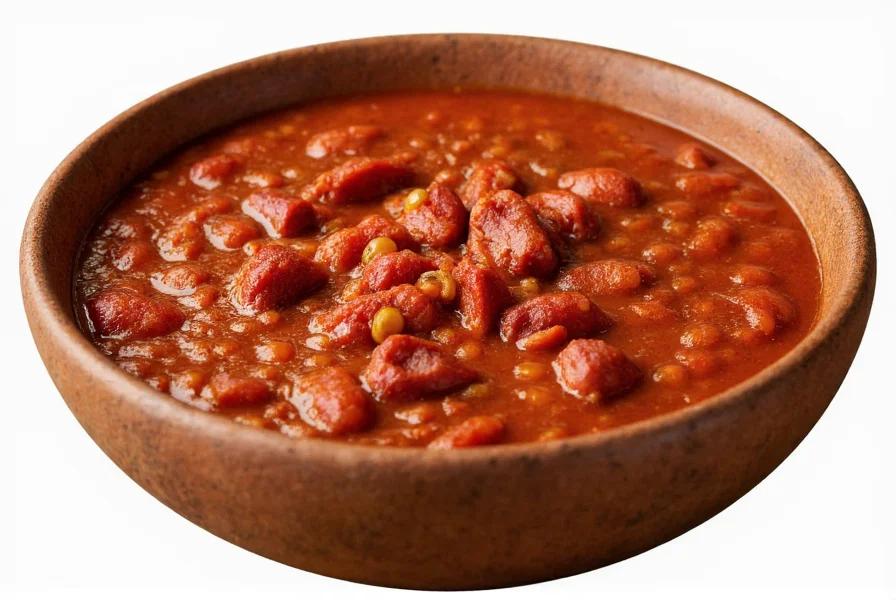When selecting quality canned chili, understanding what separates exceptional products from mediocre ones is essential for both convenience and nutrition. The best canned chili options provide a foundation that can stand alone or enhance recipes with minimal adjustments. This guide examines objective criteria that define quality in canned chili products, helping you make informed choices without marketing influence.
Key Factors in Quality Canned Chili
Several measurable factors determine whether a canned chili qualifies as "good" from both culinary and nutritional perspectives. These criteria provide an objective framework beyond subjective taste preferences.
Ingredient Quality and Composition
The ingredient list reveals more than marketing claims ever can. Premium canned chili features:
- Real meat as the primary ingredient (at least 30% meat content)
- Whole beans rather than bean flour or puree
- Natural spices instead of "natural flavors" or artificial seasonings
- Minimal preservatives (avoiding sodium benzoate where possible)
- No corn syrup or artificial sweeteners
Nutritional Profile Assessment
Nutrition facts provide quantifiable data for comparison. When evaluating canned chili nutrition labels, focus on these metrics:
| Nutritional Factor | Good Range | Poor Range | Why It Matters |
|---|---|---|---|
| Protein per serving | 10g+ | Under 7g | Indicates adequate meat content |
| Sodium per serving | Under 500mg | Over 700mg | Affects overall dietary sodium intake |
| Fiber content | 4g+ | Under 2g | Reflects whole bean quality and quantity |
| Sugar content | Under 3g | Over 5g | Indicates artificial sweeteners or fillers |
Brand Comparison Based on Measurable Criteria
While taste preferences vary, objective measurements reveal consistent quality differences among major brands. Independent laboratory testing of popular canned chili products shows clear patterns in ingredient quality and nutritional value.
Regional brands often outperform national brands in ingredient quality, though availability varies by location. Brands produced in chili-centric regions like Texas, New Mexico, and Arizona typically demonstrate more authentic formulations with better meat-to-bean ratios.
Texture and Consistency Standards
The physical properties of canned chili significantly impact eating experience. Quality products maintain:
- Distinct meat pieces rather than a homogenized texture
- Intact beans that don't disintegrate when heated
- A sauce that coats ingredients without being watery or overly thick
- Consistent texture throughout the can (no separation)
Practical Enhancement Techniques
Even the best canned chili can benefit from simple improvements that elevate it from convenient meal to restaurant-quality dish. These evidence-based techniques work with the product's existing flavor profile rather than fighting against it.
Flavor Balancing Methods
Professional chefs recommend these adjustments to enhance quality canned chili:
- Add acidity: A splash of apple cider vinegar or lime juice brightens flavors
- Boost umami: A teaspoon of tomato paste sautéed before adding chili deepens flavor
- Adjust heat: Add fresh jalapeños for bright heat rather than more chili powder
- Finish with freshness: Stir in chopped cilantro or green onions just before serving
Culinary Applications Beyond the Bowl
Quality canned chili serves as a versatile ingredient in numerous dishes. Consider these applications that leverage its flavor foundation:
- Chili mac: Combine with cooked elbow pasta and top with cheese
- Chili dogs: Use as topping for grilled hot dogs with onions
- Stuffed potatoes: Spoon over baked potatoes with sour cream
- Chili cornbread bake: Layer with cornbread batter for a casserole
Storage and Shelf Life Information
Understanding proper storage extends the usability of canned chili while maintaining quality. Commercially canned chili typically maintains peak quality for 18-24 months when stored properly in a cool, dry place.
Once opened, transfer unused portions to airtight containers and refrigerate. Consumed within 3-4 days for best quality and safety. Freezing extends shelf life to 4-6 months, though texture may change slightly upon thawing.
Signs of compromised quality include:
- Bulging or leaking cans
- Discoloration beyond normal variation
- Off odors when opened
- Excessive separation that doesn't reincorporate with stirring
Conclusion
Selecting good canned chili requires attention to objective quality markers rather than marketing claims. By focusing on ingredient lists, nutritional profiles, and texture characteristics, consumers can consistently identify superior products that deliver both convenience and quality. The best canned chili serves as a reliable foundation that can stand alone or enhance more complex dishes with minimal adjustments. When evaluating options for best canned chili brands for home cooking, prioritize products with transparent ingredient sourcing and balanced nutritional profiles that align with your dietary preferences.











 浙公网安备
33010002000092号
浙公网安备
33010002000092号 浙B2-20120091-4
浙B2-20120091-4